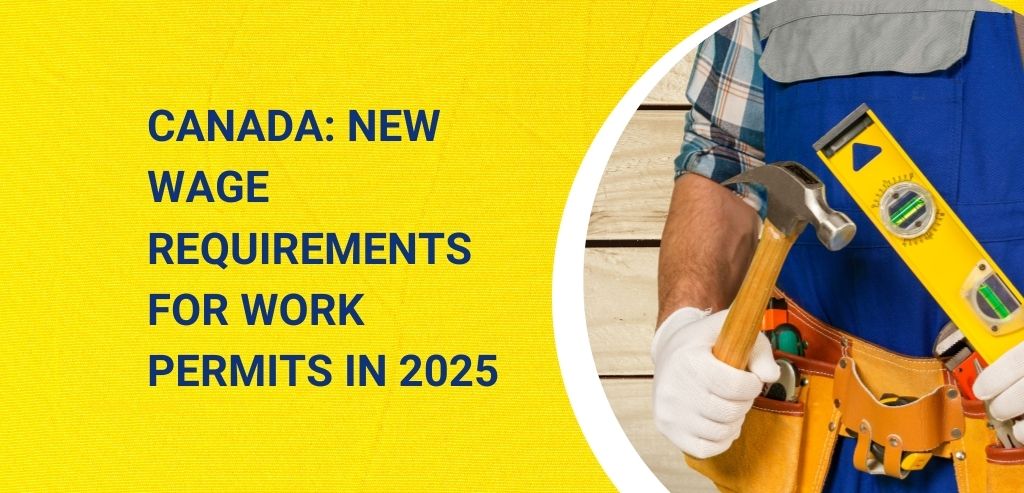As we embark on the journey of 2025, Canada introduces pivotal changes to its work permit regulations. Dive into the details of the revamped wage requirements designed to shape the employment landscape for employers, skilled workers, and immigrants. Stay ahead in the evolving world of Canadian immigration.
With the start of this new year, 2025, a significant transformation awaits individuals contemplating a work visa in Canada. Today marks the initiation of the new wage requirements for Canadian work permits, ushering in a crucial era for employers, skilled workers, and aspiring immigrants.
Let’s delve into the essential updates shaping the Canadian employment landscape in 2025.
Canada New Wage Requirements
In a significant development set to take effect in January 2025, Canada is introducing new wage requirements for work permits. Understanding these changes is crucial for navigating the Canadian employment landscape, whether you’re an employer, a skilled worker, or an aspiring immigrant.
Annual Wage Evaluations and Other Measures
The Temporary Foreign Worker Program underwent updates spearheaded by Randy Boissonnault, Minister of Employment and Social Development Canada. The Workforce Solutions Road Map introduces a comprehensive approach to aligning temporary foreign worker wages with prevailing rates.
Starting January 1, 2025, employers must conduct annual wage evaluations, ensuring fair compensation in line with occupation-specific and location-specific prevailing rates.
Additional measures, effective until August 30, 2024, include sector-specific restrictions and adjustments to the maximum term of employment based on wage levels.
Key Measures to Preserve Jobs and Wages in Canada
The new measures include preserving the clause allowing employers in designated sectors to operate and hire a maximum of 30% of their foreign labour force in low-paying jobs.
- Accommodation and Food Services
- Construction
- Manufacturing of wood products and related products
- Food manufacturing
- Lodging
- Residential care facilities
- Construction
Furthermore, the two-year maximum term of employment for jobs paying below the median hourly wage of the province or territory is retained. The labour market effect assessment’s maximum validity period has also been reduced from 18 months to 12 months to better reflect the dynamic labour market.
Monitoring and Adaptation by ESDC
The Employment and Social Development Canada (ESDC) pledges vigilant monitoring of the labour market, ensuring the Temporary Foreign Worker Program adapts to economic changes while safeguarding the interests of temporary foreign workers in Canada.
Increased Demand for Temporary Foreign Workers
As of October 8, 2023, there has been a remarkable 40% year-to-date increase in the number of files created compared to the preceding fiscal year. This surge underscores the consistently high demand for the Temporary Foreign Worker Program.
When eligible Canadians or permanent residents are unavailable, the Temporary Foreign Worker Program allows Canadian firms to engage foreign workers temporarily.
Streamlined Processes and New Initiatives
In 2023, the TFWP transitioned to an online system through the LMIA website, streamlining processes for quicker responses to labour market demands.
Additionally, the government introduced the Recognized Employer Pilot (REP) to support companies prioritizing worker safety, aiming to simplify business processes and alleviate administrative burdens.
Work Permit Processing Time in Canada
According to the most recent IRCC processing update, 80% of online work permit applications in Canada were processed in an average of 134 days over the past six months. However, processing times may vary based on permit type, location, and season.
485,000 New Permanent Residents in 2025
As per the announcement made by the IRCC, the new Immigration Levels Plan for 2024-2026 set ambitious targets to welcome 485,000 new permanent residents (PRs) in 2024, 500,000 in 2025, and maintain the level at 500,000 in 2026.
Preparing for 2024
- Employers: Stay informed about prevailing wage rates and adjust TFW salaries accordingly. Utilize the LMIA online platform for efficient processing.
- Skilled Workers: Research wage trends in your desired occupation and location. Ensure your qualifications align with Canadian demand.
- Immigrants: Keep up-to-date with TFWP updates and consider high-demand professions, especially in healthcare, where your skills are valued.
Stay Tuned for More
This is just the beginning! In a separate article, we’ll delve deeper into Canada’s top 27 in-demand immigration-supported jobs. Keep your eyes peeled for insightful analysis on immigration and employment-related topics.








